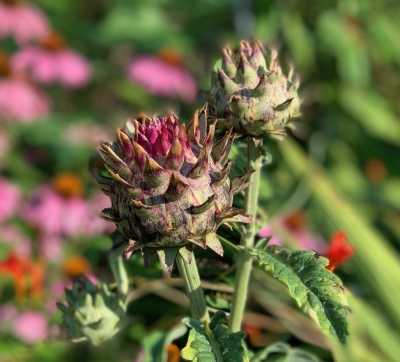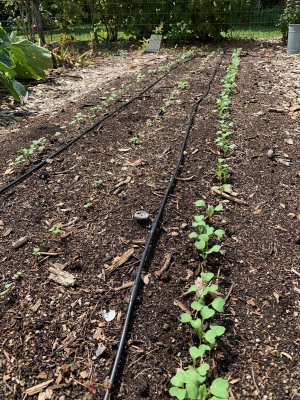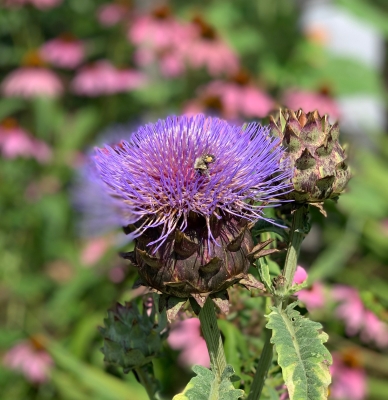Seeds Want to Grow
Yes, They Want To, But . . .
Today, as I was carefully planting a bed with turnip, arugula, and mustard seeds, I got to thinking how easy it is to grow plants from seeds. It’s not surprising. After all, seed plants evolved millions of years ago and over the years have further evolved to germinate and grow under varied conditions. This would be especially true of those plants we call weeds.

So, with all that evolution backing me up, why the great care in planting those seeds today? Seeds do want to grow, but extra care increases the chances for success. The threats to germination and growth are competition from weeds, temperatures that are too warm or not warm enough, old seed, and insufficient soil fertility, air, or moisture. That’s not all, of course; there’s too many salts in a soil (and not just NaCl “salt”), seed-eating animals, and infections from pathogenic fungi.
Whew! That list makes growing from seed seems fraught with roadblocks. But it’s not.
Steps to Improved Germination and Growth
My extra care in planting began back last autumn when I spread an inch depth of compost on top of the bed right after clearing it of garden plants and weeds. That compost provides nutrients, beneficial microbes, and increases aeration and water retention.
Earlier this season, the bed had been home to bush beans. Bean roots, left in the soil to rot, will provide further fertility — mostly nitrogen — for today’s planting.
The bean plants, and a few weeds, were cleared from the bed a couple of weeks ago, still too early for today’s planting of fall crops. While the ground was waiting, I covered it with a black tarp. The tarp, an old billboard sign (from www.billboardtarps.com and reusable for years) that is black on its back side, stimulated growth of ever present weed seeds in the soil. The seeds germinated, then died from lack of light beneath the tarp.
After year upon year of compost applications, the soil has very good tilth, so all it needed, once I removed the tarp, was a light raking to present a loose seedbed. Into it, with a trowel, I carved the first furrow the length of the bed.
Depth of planting is important. An oft-repeated rule of thumb is that the depth to sow seeds is twice their thickness. Not true! Correct planting depth needs to also take into account the looseness of the soil; looser soil, more depth. And anyway, the seeds that I planted are only about 1/32” in diameter, making it well nigh impossible to make a furrow 1/16” deep. In my loose soil, that depth would dry out too quickly. I went with the less precise “sow shallowly.”

Garden plants grown from seed can suffer from competition not only from weeds, but also from each other. True, the young seedlings could be thinned out if too crowded after germination. With seed less than two years old and care in planting, I was confident about germination, so sowed the seed thinly.
After sowing the seeds and covering them came the all-important firming of the soil. The removal of the bean plants and the pre-plant raking to smooth the surface left plenty of large pores, through which water would run right through.
Tamping down the soil with a garden rake over the covered furrow tightened up the pores so that they can hold capillary water. Remember high school chemistry class (or was it biology class) when water was shown to be drawn up into a capillary tube against the force of gravity? Firming the soil keeps moisture around the newly sown seeds; plus, water can be drawn upwards or sideways to that area. Weed seeds, sitting in still loose soil beyond the tamped area, won’t have such an easy time of it.
Finally, I watered — thoroughly enough for the water to penetrate but, to avoid washing away the seeds, not too fast. My vegetable garden has drip irrigation; I moved the drip line up right next to where the furrow was. Frequent watering is needed until seeds germinate and their new roots reach the wetting from down in the soil. An electronic moisture probe can indicate how deep moisture lies beneath the surface.
And Now for a Flower, or Is It a Vegetable?
Many years ago I grew cardoon, a vegetable whose 3-foot-high stalks are something like celery on steroids.  The flavor hints of artichoke, a close relative. None the less, for me the flavor was awful and the stalks were tough. (Cardoon is usually covered to blanche them a few weeks before harvest. Blanching did not make mine more edible.)
The flavor hints of artichoke, a close relative. None the less, for me the flavor was awful and the stalks were tough. (Cardoon is usually covered to blanche them a few weeks before harvest. Blanching did not make mine more edible.)
Yet I am now enamored with this plant — not for eating but for its thistle-like flower. Cardoon is a perennial that begins to bloom in its second year, after experiencing a period of cool temperatures in winter. Cool, not frigid; cardoon is not cold hardy here in the Hudson Valley.
Last summer I planted seed and grew the plant in pots. Those pots spent the winter in my greenhouse, where temperatures never dipping below 35° F. reminded them of their Mediterranean origin. Once warm weather settled in this spring, I planted them out in my flower garden.
The bud on one plant that has been slowly unfurling is well worth the care I put into the plants.

